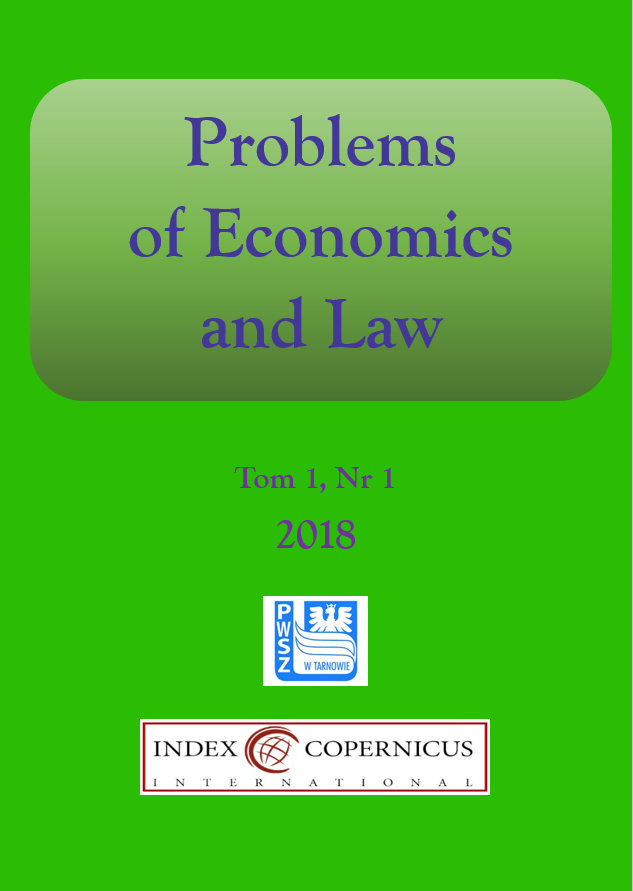The use of cross-spectral analysis to study changes in the value of stock market indices
DOI:
https://doi.org/10.5604/01.3001.0012.8260Keywords:
stock indices, spectral analysis, WIG indexAbstract
Aim of the study: The aim of the article was to examine the relationships between the main Polish index, the WIG index and selected global indices, which was intended to depict the pace and direction of the impact of changes on global financial markets.
Materials and methods: The study was conducted using a cross-spectral analysis tool, which was to determine the direction of existing relationships. Five time series were created to perform the analysis, which correspond to individual indices. They contain the results of changes in the value of individual indices for stock exchange days from July 1, 2011 to June 1, 2017.
Results: In the case of longer fluctuations, i.e. around 15 days, which were observed in the relation between the WIG index, and SnP500 and RTS, one can also indicate a clear delay in movements in the fluctuation of the Polish index value of around 10-12 days. In addition, numerous time dependencies between indices have been demonstrated, especially for the average period defined in the work.
Conclusions: The WIG index is characterized by a slower rate of absorption of short-term in-formation, as indicated by the results of delays occurring in the analyzed period. This effect indicates the unstable role of the financial market in Poland. The strongest reactions of the WIG index were observed in relation to changes in the value of the American SnP500 index and the German DAX index.
Downloads
References
FORBES, K., RIGOBON, R., No contagion, only interpedence: Measuring Stock Market Comovements, The Journal of Finance, X 2002, Tom LVII, numer 5. Google Scholar
GĘDEK, S., Analiza harmoniczna szeregów czasowych kursów walut, [w:] Trzaskalik T., Modelowanie preferencji a ryzyko ’06, Wydawnictwo Akademii Ekonomicznej w Katowicach, Katowice, 2006. Google Scholar
GÓRKA, J., OSIŃSKA, M., Efekty agregacji czasowej szeregów finansowych w świetle analizy spektralnej, [w:] Dynamiczne modele ekonometryczne, UMK, Toruń 2001. Google Scholar
HOŁUBOWICZ, K., Korelacja indeksów cen akcji na globalnych rynkach finansowych, Nauki o finansach, 2014. Google Scholar
KORABAN, Z., Wykorzystanie analizy harmonicznej w procesie prognozowania poziomu zagrożenia promieniowaniem jonizującym na terenach górniczych, ZN, Politechnika Śląska, seria: Górnictwo i Geologia, tom 6, zeszyt 1, 2011. Google Scholar
KRUSZKA, M., Wahania koniunkturalne z zmiany wybranych wartości makroekonomicznych w Polsce, Wiadomości Statystyczne, nr 5, 2001. Google Scholar
ŁUCZYŃSKI, W., Zastosowanie analizy widma wzajemnego w badaniu dynamiki indeksu giełdowego Dax, Studia Oeconomica Posnaniensia, 2015. Google Scholar
MAHADEVA, L., ROBINSON, P., Unit root testing to help model building, Bank of England, 2004. Google Scholar
MARCINKOWSKI, J., Analiza spektralna szeregów czasowych wartości wybranych indeksów na GWP, [w:] Trzaskalik T. (red.), Modelowanie preferencji a ryzyko ’02, Wydawnictwo Akademii Ekonomicznej w Katowicach, Katowice 2002. Google Scholar
MINK, M., MIERAU, J., Measuring stock market contagion with an application to the sub-prime crisis, Working Paper DNB, VII 2009, numer 217/2009. Google Scholar
OSIŃSKA, M., Ekonometria finansowa, PWE, Warszawa, 2006. Google Scholar
TALAGA, L., ZIELIŃSKI, Z., Analiza spektralna w modelowani ekonometrycznym, PWN Warszawa, 1986. Google Scholar
Downloads
Published
How to Cite
Issue
Section
License
Copyright (c) 2018 State Higher Vocational School in Tarnow, Poland & Author

This work is licensed under a Creative Commons Attribution-ShareAlike 4.0 International License.





